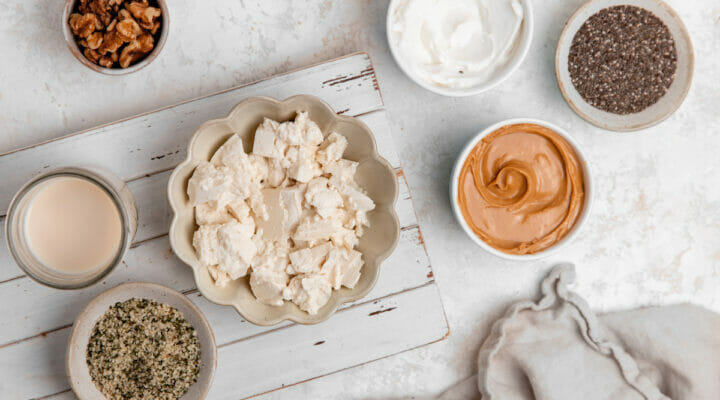10 Ways to Add Protein to Smoothies Without Protein Powder

One question I’m asked fairly regularly is how to add protein to smoothies without protein powder. It’s an understandable ask, since not everyone is a fan of protein powder. I’m generally a food-first kind of cook myself, so I tend to lean on my pantry and fridge more than the supplement aisle. Along those lines, I thought I’d offer some ideas for how to make a protein-rich smoothie using whole foods.

Why Not Use Protein Powder?
This is also a good question given how easy it is to add a couple of scoops of protein powder to a blender. If it’s an ingredient you rely on for ease or any other reason, there’s no judgement here. I sometimes use it small doses myself, but don’t particularly care for the taste or texture. Plus, the whole foods I use in smoothies offer a host of other benefits beyond protein. Here are a few examples:
- Kefir has gut-healthy probiotics and calcium
- Hemp seeds have heart healthy Omega-3 fats and magnesium
- Peanut butter has vitamin E and fiber

Tips for Adding Protein to Smoothies
Before I dig into all the options, here are a few suggestions to guide you on your way.
- Aim for a minimum of 10 grams of protein in a smoothie. If you’re drinking it for a main meal (as opposed to a snack), aim for 20 plus grams (the amount comparable to a typical scoop of protein powder).
- Know that protein shows up in a wide variety of foods well beyond fish, meat, and chicken. Yogurt and other dairy products, beans, legumes, grains, dairy products, and even fruits and vegetables provide protein.
- Getting a decent dose of protein without protein powder likely means relying on a combination of food sources that collectively add up. For example, a smoothie made with berries, milk, cashew butter, spinach, and hemp seeds, derives protein from all of those ingredients to reach the 20 gram goal.
- Don’t lean too heavily on plant milk for protein. Other than soy and pea milk, most plant milks only offer a few grams per cup.

10 Foods to Add Protein to Smoothies without Protein Powder
Below is a breakdown of the protein content of a variety of foods. The amount can vary slightly depending on the variety and brand.
Greek Yogurt
- 10 to 12 grams protein per ½ cup plain. Conventional yogurt has about half that amount. Opt for plain yogurt to minimize added sugar, then sweeten it yourself with ripe bananas, dates, other fruits, maple syrup, or honey.
Kefir
- 10 grams protein per cup. Opt for plain kefir to minimize added sugar.
Cow/Soy/Pea milk
- 8 grams protein per cup of cow’s milk, 6 grams for soy milk, and 8 grams for pea milk. Opt for unsweetened milks with minimal added ingredients.
Cottage Cheese
- 12 grams protein per 1/2 cup. It’s worth noting that cottage cheese is a little high in sodium, so something to know if you’re watching your intake.
Tofu
- 6 grams protein per 3 ounces silken tofu. This is soft tofu, which blends easily into smoothies.
- 15 grams protein per 3 ounces firm tofu.
Nut, Seed, and Peanut Butter
- 6 to 8 grams protein per 2 tablespoons of nut, peanut, and seed butters. This includes everything from almond and cashew butter to sun butter and tahini.
Nuts and Peanuts
- 4 to 9 grams protein per ¼ cup. Peanuts have the highest amount per ounce. Soft nuts, such as cashews and walnuts blend particularly. Soaking nuts for an hour or longer (in whatever liquid you’re using for your smoothie) will help nuts blend smoothly.
Seeds
- 4 to 7 grams protein per 2 tablespoons of hemp, chia, flax, pumpkin, and sunflower seeds. Hemp seeds have the highest at 7 grams.
Chickpeas
- 3 grams protein per 1/3 cup. Chickpeas also add fiber, which makes smoothies extra filling.
Whole Grains
- 3 grams per 1/4 cup uncooked oats. Blends easily into smoothies and gives it thickness.
- 2 grams per 1/4 cup cooked quinoa.

Smoothie Combinations that Deliver Plenty of Protein
The chart below offers a handful of ideas for food combinations that add up to plenty of protein, with options for dairy-free and vegan in the mix.

If you like learning how to add protein to smoothies without protein powder, you might like these other posts:
How Much Protein to Eat and Why
How to Feed your Vegetarian Child
How Much Protein a Child Needs
8 Ideas to Boost Protein and Calcium
Much gratitude to my nutrition intern Hannah Zimmerman, who conducted research for this post and took the photographs. You can find more of her work here.





Comments